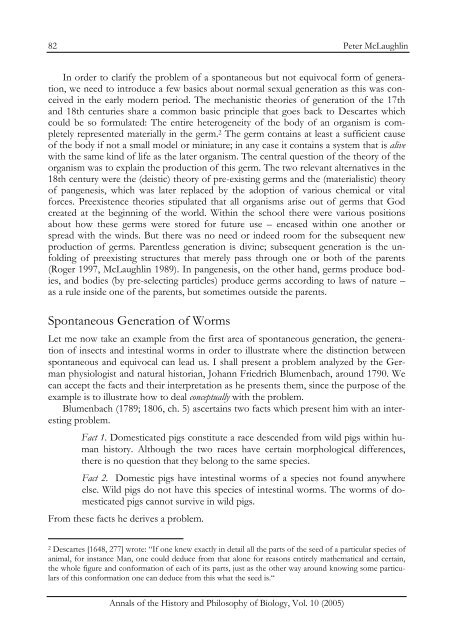Annals of the History and Philosophy of Biology
Annals of the History and Philosophy of Biology
Annals of the History and Philosophy of Biology
Create successful ePaper yourself
Turn your PDF publications into a flip-book with our unique Google optimized e-Paper software.
82<br />
<strong>Annals</strong> <strong>of</strong> <strong>the</strong> <strong>History</strong> <strong>and</strong> <strong>Philosophy</strong> <strong>of</strong> <strong>Biology</strong>, Vol. 10 (2005)<br />
Peter McLaughlin<br />
In order to clarify <strong>the</strong> problem <strong>of</strong> a spontaneous but not equivocal form <strong>of</strong> generation,<br />
we need to introduce a few basics about normal sexual generation as this was conceived<br />
in <strong>the</strong> early modern period. The mechanistic <strong>the</strong>ories <strong>of</strong> generation <strong>of</strong> <strong>the</strong> 17th<br />
<strong>and</strong> 18th centuries share a common basic principle that goes back to Descartes which<br />
could be so formulated: The entire heterogeneity <strong>of</strong> <strong>the</strong> body <strong>of</strong> an organism is completely<br />
represented materially in <strong>the</strong> germ. 2 The germ contains at least a sufficient cause<br />
<strong>of</strong> <strong>the</strong> body if not a small model or miniature; in any case it contains a system that is alive<br />
with <strong>the</strong> same kind <strong>of</strong> life as <strong>the</strong> later organism. The central question <strong>of</strong> <strong>the</strong> <strong>the</strong>ory <strong>of</strong> <strong>the</strong><br />
organism was to explain <strong>the</strong> production <strong>of</strong> this germ. The two relevant alternatives in <strong>the</strong><br />
18th century were <strong>the</strong> (deistic) <strong>the</strong>ory <strong>of</strong> pre-existing germs <strong>and</strong> <strong>the</strong> (materialistic) <strong>the</strong>ory<br />
<strong>of</strong> pangenesis, which was later replaced by <strong>the</strong> adoption <strong>of</strong> various chemical or vital<br />
forces. Preexistence <strong>the</strong>ories stipulated that all organisms arise out <strong>of</strong> germs that God<br />
created at <strong>the</strong> beginning <strong>of</strong> <strong>the</strong> world. Within <strong>the</strong> school <strong>the</strong>re were various positions<br />
about how <strong>the</strong>se germs were stored for future use – encased within one ano<strong>the</strong>r or<br />
spread with <strong>the</strong> winds. But <strong>the</strong>re was no need or indeed room for <strong>the</strong> subsequent new<br />
production <strong>of</strong> germs. Parentless generation is divine; subsequent generation is <strong>the</strong> unfolding<br />
<strong>of</strong> preexisting structures that merely pass through one or both <strong>of</strong> <strong>the</strong> parents<br />
(Roger 1997, McLaughlin 1989). In pangenesis, on <strong>the</strong> o<strong>the</strong>r h<strong>and</strong>, germs produce bodies,<br />
<strong>and</strong> bodies (by pre-selecting particles) produce germs according to laws <strong>of</strong> nature –<br />
as a rule inside one <strong>of</strong> <strong>the</strong> parents, but sometimes outside <strong>the</strong> parents.<br />
Spontaneous Generation <strong>of</strong> Worms<br />
Let me now take an example from <strong>the</strong> first area <strong>of</strong> spontaneous generation, <strong>the</strong> generation<br />
<strong>of</strong> insects <strong>and</strong> intestinal worms in order to illustrate where <strong>the</strong> distinction between<br />
spontaneous <strong>and</strong> equivocal can lead us. I shall present a problem analyzed by <strong>the</strong> German<br />
physiologist <strong>and</strong> natural historian, Johann Friedrich Blumenbach, around 1790. We<br />
can accept <strong>the</strong> facts <strong>and</strong> <strong>the</strong>ir interpretation as he presents <strong>the</strong>m, since <strong>the</strong> purpose <strong>of</strong> <strong>the</strong><br />
example is to illustrate how to deal conceptually with <strong>the</strong> problem.<br />
Blumenbach (1789; 1806, ch. 5) ascertains two facts which present him with an interesting<br />
problem.<br />
Fact 1. Domesticated pigs constitute a race descended from wild pigs within human<br />
history. Although <strong>the</strong> two races have certain morphological differences,<br />
<strong>the</strong>re is no question that <strong>the</strong>y belong to <strong>the</strong> same species.<br />
Fact 2. Domestic pigs have intestinal worms <strong>of</strong> a species not found anywhere<br />
else. Wild pigs do not have this species <strong>of</strong> intestinal worms. The worms <strong>of</strong> domesticated<br />
pigs cannot survive in wild pigs.<br />
From <strong>the</strong>se facts he derives a problem.<br />
2 Descartes [1648, 277] wrote: “If one knew exactly in detail all <strong>the</strong> parts <strong>of</strong> <strong>the</strong> seed <strong>of</strong> a particular species <strong>of</strong><br />
animal, for instance Man, one could deduce from that alone for reasons entirely ma<strong>the</strong>matical <strong>and</strong> certain,<br />
<strong>the</strong> whole figure <strong>and</strong> conformation <strong>of</strong> each <strong>of</strong> its parts, just as <strong>the</strong> o<strong>the</strong>r way around knowing some particulars<br />
<strong>of</strong> this conformation one can deduce from this what <strong>the</strong> seed is.“

















